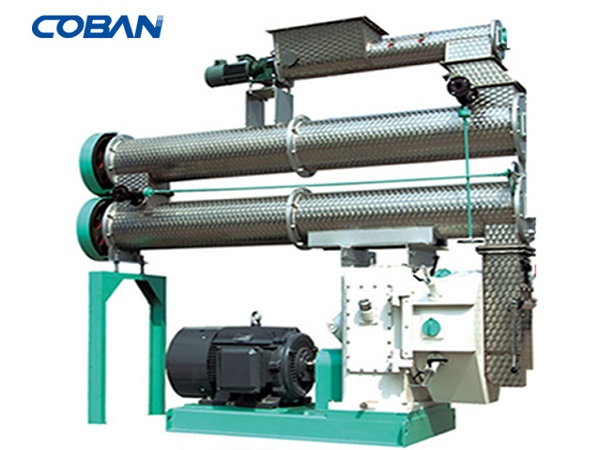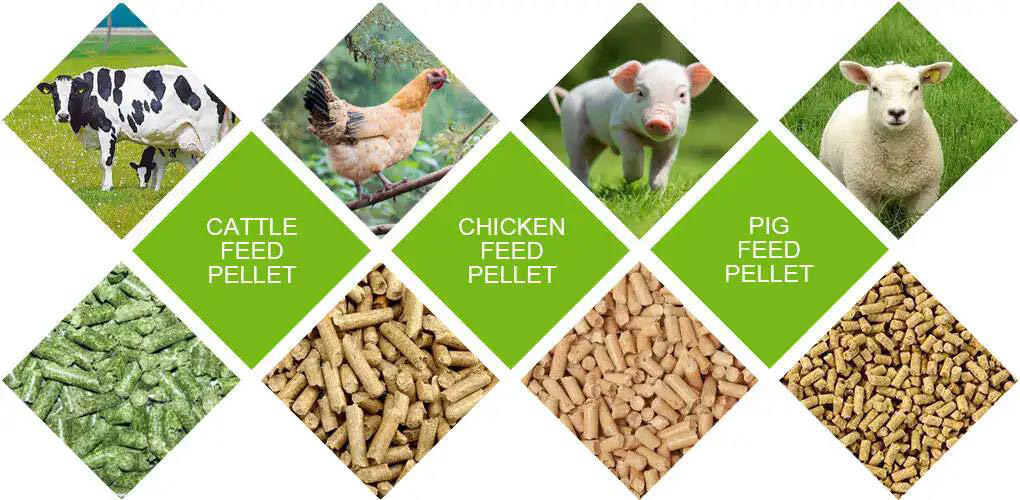pellet feed machine
A pellet feed machine is a specialized piece of equipment used to compress powdered raw materials into pellet feed. Widely used in agriculture and animal husbandry, it primarily produces feed pellets for livestock and poultry.
pellet feed machine Introduction
A pellet feed machine is a specialized piece of equipment used to compress powdered raw materials into pellet feed. Widely used in agriculture and animal husbandry, it primarily produces feed pellets for livestock and poultry. Utilizing a pellet feed machine can effectively enhance feed digestibility and absorption, reduce feed waste, and facilitate storage and transportation.


Main features of pellet feed machine
Compression Process
The pellet feed machine compresses and extrudes powdered or paste-like feed materials into pellets of a specific shape and size. These pellets are usually easier for animals to digest and absorb.
Variety of Raw Materials
The pellet feed machine can process various raw materials, including grains, legumes, grass powder, fish meal, bone meal, corn, and soybean meal. Different materials can be mixed and processed according to the nutritional needs of different animals.
High Production Efficiency
The pellet feed machine typically has high production capacity, enabling the rapid production of large quantities of feed pellets to meet the demands of large-scale farms.
Adjustable Settings
Many pellet feed machines allow users to adjust the size and density of the pellets to meet the needs of different animals and growth stages.
Durability
Pellet feed machines are usually made of sturdy and durable materials, capable of running stably for long periods, reducing maintenance costs.
Environmental and Energy Efficiency
Modern pellet feed machines are designed with an emphasis on environmental protection and energy efficiency, reducing energy consumption and waste during production.


Main structure of pellet feed machine
Feeding System
This includes the hopper and feeder, which uniformly deliver raw materials into the compression chamber. The hopper stores the materials to be processed, and the feeder controls the feeding rate, ensuring a continuous and stable flow of materials into the compression process.
Conditioner
The conditioner treats the raw materials by adding steam or moisture, making them enter the compression chamber at an optimal temperature and humidity. This helps improve pellet quality and compression efficiency.
Compression System
This is the core part of the pellet feed machine, consisting of rollers, a ring die (or flat die), and a main shaft. The rollers push the materials into the holes of the ring die, extruding them into pellets.
Cutting System
After the pellets are extruded from the ring die, the cutting knives cut them to the desired length. This part of the structure can be adjusted to meet different length requirements.
Transmission System
This includes the motor, reducer, and transmission belts, which transmit power from the motor to the rollers and ring die, ensuring the machine operates correctly.
Lubrication System
To ensure the machine runs stably for long periods, the lubrication system lubricates the moving parts, reducing wear and preventing malfunctions.
Cooling System
The compression process generates heat, so the cooling system cools the freshly extruded pellets, increasing their hardness and making them easier to store and transport.
Control System
Modern pellet feed machines are equipped with automated control systems that adjust operating parameters and monitor the machine’s status. These features enhance production efficiency and safety.
Discharge System
This includes the discharge port and conveyor, which transport the cooled pellets to the next stage or storage.


Main advantages of pellet feed machine
Improves Feed Utilization
The pellet feed machine increases the density of the feed through compression and conditioning processes. The pellets are uniform, and the distribution of nutrients is more even, aiding in better digestion and absorption by animals. This improvement in nutrient absorption enhances feed utilization.
Reduces Feed Waste
Compared to powdered feed, pellet feed is less likely to be blown away by the wind or clump together due to moisture. This reduces loss during feeding and significantly cuts down on feed waste.
Facilitates Storage and Transportation
Pellet feed undergoes high-temperature processing during compression, reducing moisture content. The hard pellets are less prone to spoilage, making long-term storage and long-distance transportation easier.
Enhances Animal Health
The high-temperature treatment in pellet feed production sterilizes the feed, killing bacteria and parasites. This reduces the incidence of diseases in animals and improves overall animal health.
Ensures Nutritional Balance
During the pelleting process, various nutritional components can be evenly mixed according to the animals’ dietary needs. This ensures that each feed pellet has a balanced nutritional composition.
Increases Production Efficiency
The pellet feed machine, with its high degree of automation, significantly boosts production efficiency. This allows for the mass production of feed pellets in a short period to meet the demands of large-scale farms.
Promotes Environmental and Energy Efficiency
Modern pellet feed machines are designed with energy-saving and environmental considerations, featuring low energy consumption, low noise, and minimal dust and waste generation during production, thus meeting environmental protection standards.
Simplifies Operation
The pellet feed machine is easy to operate and maintain, requiring no complex operational skills, making it user-friendly and easy to train for.
Offers Cost Efficiency
Although the initial investment in a pellet feed machine is relatively high, the resulting improvements in feed utilization, waste reduction, and production efficiency significantly lower long-term feeding costs and enhance economic benefits.
Application of pellet feed machine
Typically, the production of pellet feed machine uses raw materials such as corn, soybeans, wheat, and other nutrients as the formula. Our pellet feed machine are specially used to produce feed for poultry, livestock, pigs, horses, cattle, sheep, chickens, ducks, goose and other animals.For different animals, with different growth cycles, (chicks, suckling pigs, calves, etc.), the feed pellet size required is different, but our feed production line only needs to replace ring molds with different apertures or use a pellet crumbler to reach the required size.

Parameter of feed pellet machine
| Model | Capacity | Main Motor Power | Feeder Motor Power | Conditioner Power | Dia. of Ring Die | Pellet Size |
| SZLH250 | 1-2T/H | 22KW | 0.75kw | 1.5kw | 250mm | 2-12mm |
| SZLH320 | 3-4T/H | 37KW | 1.5kw | 2.2kw | 320mm | 2-12mm |
| SZLH350 | 5-7T/H | 55KW | 1.5kw | 3kw | 350mm | 2-12mm |
| SZLH420 | 8-12T/H | 110KW | 1.5kw | 7.5kw | 420mm | 2-12mm |
| SZLH508 | 10-18T/H | 160KW | 2.2kw | 11kw | 508mm | 2-12mm |
| SZLH558 | 15-25T/H | 180KW | 2.2kw | 11kw | 558mm | 2-12mm |
| SZLH678 | 20-30T/H | 220KW | 2.2kw | 11kw | 678mm | 2-12mm |
| SZLH768 | 25-42T/H | 280KW | 2.2kw | 11kw | 768mm | 2-12mm |







